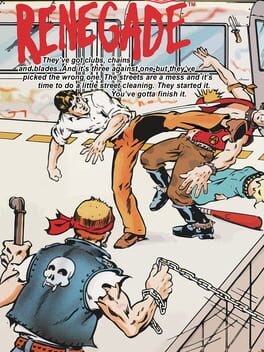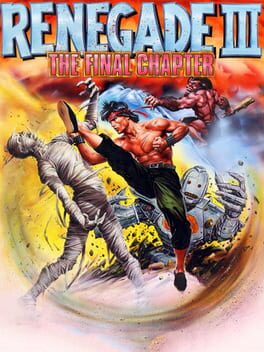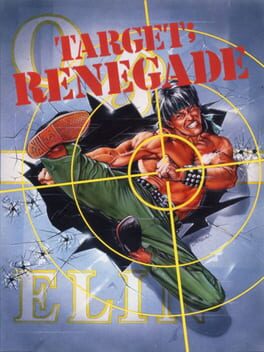

A port of Nekketsu Renegade Kunio-kun
Unlike Technos' subsequent game Double Dragon, the playing field is limited to one two-screen-wide area (a subway platform, a harbor, an alley, a parking lot and the hideout of a gang) and does not scroll continuously. Out of the four stages in the game, the first, second and third each begin with the player fighting a group made up of two different types of small fry enemies: one with fewer hit points and a stronger attack (usually armed with a weapon) and one with more hit points, but with a weaker attack and the ability to grab the player from behind, making him vulnerable to other enemies' attacks. When only three underlings remain (in any combination of the two) their boss will come in from the sidelines and join the fight. When the boss is defeated, any remaining enemies retreat off the bottom of the screen, and the stage ends. The second stage follows this same formula, but begins with a series of enemies riding motorcycles trying to run the player down, and brings in the normal enemies once the bikers have been defeated. The third stage is a gang of women; their boss is a very large woman who cannot easily be knocked to the ground. The fourth stage features a single type of knife-wielding enemy who can kill the player with one hit. Once the player has defeated this first wave of enemies, the main character proceeds to enter a building at the far right of the stage. There, he faces three more knife-wielding enemies and the final boss, a mobster whose gunfire is also deadly with one hit. Once the final boss is defeated, the main character exits the building and is greeted by his rescued girlfriend, who proceeds to give him a kiss. The game then begins the next cycle with an increased difficulty. In addition to an eight-direction joystick, there are three buttons; left attack, right attack, and jump. Pressing the attack in the direction the character is facing will punch, while attacking in the opposite direction will perform a rear kick. Jumping, followed immediately by one of the attack buttons, which will perform a jumping kick in the direction of the attack. Pressing the joystick twice quickly either left or right will cause the player to run, at which point attacking in the direction of the run will perform a running punch, jumping will automatically perform a flying kick, and attacking in the opposite direction will bring the player to a sudden halt and perform a back-kick. Pressing down over a downed enemy will make the player sit on top of the enemy, at which point attacking toward the enemy will cause the player to pummel him. The bosses can only be sat on if all normal enemies have been defeated, and unless the boss' energy level is low enough, he'll throw the player off.
Also in series
Released on
Genres
Reviews View More
Before I begin this im going to note im cheating a little bit here. I don't actually own the Tecnos cart and given its currently out of print and sells for silly money, im probably never owning it. What I'm playing are the versions on the Double Dragon & Kunio-Kun collection on the switch, so take that as you will.
Onto the first and its like running into a brick wall difficulty wise, that first initial stage is so mean spirited and brutal to the point where it can feel like an impossible task to comprehend.
Once you get the hang of it though, and discover that spamming jump-kick is pretty much the main viable solution to all problems, the game does kick up into gear, even if fundamentally its still rather clunky and rough around all the edges and thats pretty much to be expected of a game that both launched an entire subgenre and an expansive franchise.
As the very first game in the series, as well as my first experience with the series, I found myself liking my time with the game, but I will admit, I did find it frustrating in plenty of instances. Maybe it is because I suck at the game, but I had a rough time with it, but I still overall had fun with it.
The story is basically the exact same as Double Dragon, at least in the American version, but I don't really mind it being repeating, the graphics are pretty good, especially the art style on the characters, being different from what I am used to, the music, while a lot of it feeling samey, is nice to listen to, the control is a little awkward, but you can get used to it pretty quickly, and the gameplay is your classic beat-'em-up affair, going from stage to stage beating up goons, having plenty of different moves to use to fight said goons, with gimmicks throughout to differentiate gameplay, such as one section of the game where you are fighting people on a motorcycle, which I found to be pretty enjoyable.
As I mentioned before though, I did find this game pretty frustrating, primarily because of its difficulty. Again, this may just because I suck, but I found this game to be pretty damn difficult. It seemed that no matter what I did, I would always get hit by enemies whenever I tried to hit them, which yeah, is a common thing in other fighting games of this era, but I felt it the most here. Then again, this became less of an issue when I discovered the ability of jump kicking, and I just spammed that for pretty much the entire game, and no, I am not sorry for doing that.
In addition, while I do appreciate and like most of the gimmicks of the stages, there is one gimmick in the final stage that REALLY annoyed me. You are basically in a maze, where every time you defeated a group of enemies, you have to go through one door in a group of doors, and if you choose the wrong series of doors, you can be lost in this maze of rooms for a while, constantly refighting the same enemies over and over again. Sure, you will have infinite time to do it, but let me tell you, it is not fun constantly doing the same thing over and over again just to figure out which direction to go.
Overall, while I did have my fair share of hardships with this entry, I still overall found it to be a fun enough fighting game of the NES era, and a pretty competent start to the overall River City series. I just hope it does get better from here.
Game #67
Nekketsu Kōha Kunio-kun is probably the first attempt at a truly formalized game by Technos. As an expansion of the concept already introduced by Karate Dō (1984), the game here features greater variety, while fully embracing its beat'em up aspect, which was just starting to gain popularity at the time. The main difference lies in Yoshihisa Kishimoto's philosophy, which favours much longer fights than was usual at the time. His emphasis on combos also allows for much more cinematic setpieces inspired by Hong Kong martial arts films.
Unlike the American version, whose redesign work was extensive, the player here takes on the role of Kunio, a character based on Kishimoto. He goes in search of his friend, Hiroshi, who was abducted and beaten by a number of high school gangs. The player progresses through four different stages, themselves divided into different panels; to reach the next one, a number of enemies must be defeated. Contrary to the platform beat'm up tradition, Nekketsu Kōha Kunio-kun opts for a downward perspective view, permitting horizontal and vertical movement. Such a choice places a new emphasis on positioning, so as not to be overwhelmed by opponents.
As with Karate Dō, the A and B buttons do not yet have fixed roles and perform different commands, depending on the direction of the character. Whereas the list of combinations was cryptic and far too dense in Karate Dō, Nekketsu Kōha Kunio-kun simplifies the process by assigning a leftward attack to the B button and a rightward attack to the A button. It takes some time to get used to it for modern players, but the system is quite robust. Beyond the classic punches and kicks, the title lets players grab characters to knee them, which opens up the possibility of throwing - both to knock down other opponents and to throw them onto the underground tracks or into Tokyo Bay. Similarly, it is possible to chain attacks on downed opponents, as long as no other enemy interrupts. In difficulty levels 2 and 3, it is necessary to be familiar with the stun system in order to create enough space, but the game remains generous with the life bar: the title manages to keep its arcade aspect, while allowing the player to make some mistakes.
The bosses suffer a bit more from this observation. The richness of the gameplay really comes from the grabs and throws, but they are immune to them. Since players have to beat them in a conventional way and the range of Kunio's strikes is still quite short, some unsatisfactory solutions emerge. These include okizeme jump kicks or dashes to prevent bosses from acting; while these methods are frustrating, they become indispensable in the higher difficulties, where multiple bosses can be encountered on the same screen. In this regard, the game follows a very linear logic, except for its final stage, which is a sort of labyrinth to access the final boss. This design choice is rather puzzling and, while it is understandable from a diegetic standpoint, is mostly a source of irritation.
Stylistically, the title draws on Kishimoto's high school years and the success of banchō manga in the 1970s and 1980s, the reference to Be-Bop High School (1984) being quite noticeable. This success occurred as Japan was curbing male juvenile violence, which peaked in 1964, when the post-war generation was attending high school. The imagery of Nekketsu Kōha Kunio-kun is thus already an idealised construction of Japanese gangs: it is not surprising that the haircuts are largely inspired by the 1950s. The underground line has that slightly old-fashioned look, which doesn't fit so well with a Tokyo living at the pace of business. Similarly, the harbour has a rather detached feel to it, with the motorbikes and racing cars delineating the arena. The whole representation is designed to accommodate a popular subculture that seems divorced from the socio-economic development of the country, one of the ways in which Japanese youth expressed their discontent. This aspect seems to be carried in Kunio-kun's catchphrase 「おめえら なめてんじゃねえぞ」.
This aestheticism, if it remained present in the Kunio-kun series, disappeared rather quickly from the beat'em up landscape, as production tried to appeal more to Americans with gang wars, which were successful across the Pacific at the time, as illustrated by Double Dragon (1987). Nevertheless, Nekketsu Kōha Kunio-kun remains an essential title, throwing out a significant number of ideas, while having a unique atmosphere, thanks to its sensibility to Japanese subculture, that the NES games sometimes struggle to find. If the title remains a bit simplistic and sometimes frustrating in its last stage, it is historically essential to understand the transition from horizontal scrolling to belt scrolling in the beat'em up genre.
The combat is pretty cool but the final level is a random maze designed to make you replay a bunch of the game which isn't fun at all and the double Riki boss fight sucks and the Misuzu boss fight sucks and the final boss is awful because he has a gun that kills you instantly and he can pull it out and shoot faster than you can get out of the way or counter, you have to take little potshots at him or try to lock him into a combo and then run away once he's downed.
Once you finally beat the game you get a little cutscene of Kunio hugging Hiroshi, the credits roll, and the game is over. 終 and all that.
The game is fun if you're in the right mindset, but... eh. It sucks. Nice to look back on as a little relic of a time gone by, but nothing great or mindblowing.


